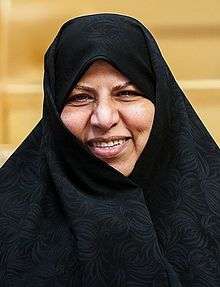Marzieh Vahid-Dastjerdi
| Marzieh Vahid-Dastjerdi | |
|---|---|
 | |
| Minister of Health and Medical Education | |
|
In office 9 August 2009 – 31 March 2013 | |
| President | Mahmoud Ahmadinejad |
| Preceded by | Kamran Bagheri Lankarani |
| Succeeded by | Hassan Tarighat Monfared |
| Member of the Parliament of Iran | |
|
In office 28 May 1992 – 28 May 2000 | |
| Constituency | Tehran, Rey, Shemiranat and Eslamshahr |
| Majority | 1,025,629 (36.20%)[1] |
| Personal details | |
| Born |
11 February 1959 Tehran, Iran |
| Nationality | Iranian |
| Political party | Zeynab Society |
| Other political affiliations | Islamic Association of Physicians of Iran |
| Spouse(s) | Omid Nokhostin[2] |
| Children | 2 |
| Relatives |
Seifollah Vahid-Dastjerdi (father) Elaheh Vahid-Dastjerdi (sister) Hamid Vahid-Dastjerdi (brother) Ahmad Vahid-Dastjerdi (brother) Mohammad Esfahani (cousin)[3] |
| Alma mater | University of Tehran |
| Religion | Shia Islam |
| Signature |
 |
Marzieh Vahid-Dastjerdi (born 11 February 1959, Persian: مرضیه وحید دستجردی) is an Iranian university professor and former parliamentarian, who was Iran's minister of health and medical education.[4] She was part of the President Mahmoud Ahmedinejad's inner circle.[5]
Vahid-Dastjerdi was the first female government minister in Iran since the Islamic Revolution. She is the third female government minister in Iranian history, after Farrokhroo Parsa and Mahnaz Afkhami.[6]
Early life and education
Marzieh Vahid-Dastjerdi was born in Tehran on 11 February 1959. She is the daughter of Seifollah Vahid Dastjerdi, who was head of the Red Crescent Society of Iran.[7]
She entered Tehran University of Medical Sciences in 1976 to study medicine, and qualified in nursing and obstetrics, obtaining a doctoral degree in 1988.[7][8]
Medical career
Vahid-Dastjerdi was a faculty member at Tehran University for 13 years, and director of the Nursing and Obstetrics Department for six years. She was a founder member of Iran's Specialized Scientific Association of Reproduction and Sterility, and a member of the American Society for Reproductive Medicine (1993–2000).[7] From 2004 to 2009 she headed Arash Hospital.[8]
Vahid-Dastjerdi worked on the organizing committees for prominent conferences on subjects related to medicine. Examples include a Workshop on “Higher Education & Development in Knowledge Based Society: Towards Enhancing Quality and Relevance in Medical and Professional Education”[9] and the 2nd International Congress of Medical Ethics in Iran which took place in Tehran during April 2008.[10]
She is a member of the editorial board of the Tehran University of Medical Sciences's Journal of Family and Reproductive Health.[11]
Political career
Vahid-Dastjerdi in 1993 jointly founded the Islamic Association of Physicians, a political party.[12] She was elected to the Fourth Majlis (1992–1996) representing Tehran, and re-elected in 1996.[13][14] She was elected chairwoman of the Majlis Committee on Women, Family and Youth in August 1997.[15]
While in the Majlis, Vahid-Dastjerdi supported legal changes making it harder for women to obtain a divorce, keep custody of their children after divorce, or have an abortion. She is described by one critic as supporting the role of women as "pious mothers devoted to Islam, to their duties to their husbands, and to the Islamic Republic." She opposed a bill that might have led Iran to join the United Nations Convention on the Elimination of All Forms of Discrimination Against Women.[16]
In April 1998, Vahid-Dastjerdi helped draft a proposal for sexual segregation in hospitals and medical institutions to comply with Sharia. This plan envisaged female hospitals for women staffed exclusively by women, on a model sharing some features of London's Elizabeth Garrett Anderson Hospital, which led to the founding of the London School of Medicine for Women. The plan was eventually rejected on grounds of cost, after heavy criticism from doctors and health professionals.[13] A similar plan to separate Iranian hospitals by gender, based on Vahid-Dastjerdi's original proposal, was enacted in 2006.[17] The president of the Council of Iranian Medical Specialists described the plan as "not even realistic” because of the "shortage of female specialists in many cities".
In May 1999, she addressed a rally in Tehran to protest the ban on wearing the headscarf in the Turkish parliament. She condemned the ban as an affront to Muslims and a crime against human rights.[18]
On 3 September 2009, the Majlis confirmed Vahid-Dastjerdi as Iran's Minister of Health and Medical Education. She received 175 favoring, 82 opposing, and 29 abstaining votes, and is the first female minister in the history of the Islamic Republican government. On the same day, two other female candidates for ministries (Sousan Keshavarz and Fatemeh Ajorlou) were voted down.[19]
Vahid-Dastjerdi is considered politically conservative, but supports a role for women in society. She told parliamentarians "Women must have a greater role in the country's affairs." After her confirmation, she said "I think today women reached their long-standing dream of having a woman in the cabinet to pursue their demands. This is an important step for women and I hold my head high."[20] On 27 December 2012, she was removed from her position as health minister.[21] Mahmoud Ahmadinejad appointed her deputy, Mohammad-Hassan Tarighat Monfared, as caretaker of the ministry until a new minister is approved by the parliament.[22]
Publications
She has written and translated many books in the field of women's health.[7] The following is probably not a complete list.[23][24]
- Jannani S, Vahid-Dastjerdi M. "Relationship of placenta accreta to previous cesarean section". 5th Seminar of Fertility and Infertility, Tehran, February 1991.
- Vahid-Dastjerdi M, Moalleman M. Cesarean section indications in Arash hospital, 1994 [PhD thesis]. Tehran, Tehran University of Medical Sciences, Department of Gynecology and Obstetrics, 1995.
- Ramazanali F., Vahid Dastjerdi M., Beigi A., Moini A. "The Relationship Between Maternal HCT Levels, Birth Weight And Risk Of Low Birth Weight", Iranian Journal Of Pediatrics, Winter 2006; 16(4):447–454.
- Vahid Dastjerdi M., Alavi Tabari N., Asgari Z., Beygi A. "The relationship of endometrial thickness detected by transvaginal sonography with the results of endometrial biopsy & hysteroscopic directed biopsy in post menopausal bleeding", Tehran University Medical Journal; Vol. 65, No. 11, Feb 2008
- Moeini Ashraf, Shafieizadeh N., Vahid Dastjerdi M., Majidi Sh., Eslami B. "The Effect Of Age On Ovarian Reserve Markers In Tehranian Women With Normal Fertility", International Journal Of Endocrinology And Metabolism (IJEM), June 2008; 6(2):114–119.
References
- ↑ Profile
- ↑ زندگی خصوصی وعمومی نخستین خانم وزیر
- ↑ خانه / آخرین اخبار / محمد اصفهانی و مرضیه وحید دستجردی عزادار شدند محمد اصفهانی و مرضیه وحید دستجردی عزادار شدند
- ↑ ماجرای برکناری اولین وزیر زن (in Persian)
- ↑ Abdo, Geneive (29 July 2010). "Iran's Bubble Boys". Foreign Policy. Retrieved 27 July 2013.
- ↑ The first woman minister in the Islamic Republic BBC, (in Persian), 3 September 2009
- 1 2 3 4 Marzieh Vahid Dastjerdi joins government as Minister of Health Mehr News, (Persian)
- 1 2 1st female minister in the history of Islamic Republic of Iran Payvand
- ↑ "Committees". Higher Education. Retrieved 27 December 2012.
- ↑ "2nd International Congress of Medical Ethics in Iran". ICME. 16–18 April 2008. Retrieved 27 December 2012.
- ↑ "About this journal". TUMS. Retrieved 27 December 2012.
- ↑ "List of Legally Registered parties in Iran". Pars Times. Retrieved 27 December 2012.
- 1 2 Appendix: Chronology of Events Regarding Women in Iran since the Revolution of 1979
- ↑ Islamic Republic of Iran Parliament (Majlis)
- ↑ Representative Office of The National Council of Resistance of Iran Brief on Iran No. 735
- ↑ Hardline women won't help Iran The Guardian, 17 August 2009
- ↑ A Minister in Support of Gender Separation
- ↑ Turkey's secular fundamentalists target woman over hijab
- ↑ "فارسی - ايران - مجلس به سه وزیر پیشنهادی احمدی نژاد رای اعتماد نداد". BBC. 3 September 2009. Retrieved 17 February 2013.
- ↑ Dream win for female minister Gulf Daily
- ↑ "Iran sacks sole female minister Dastjerdi from health post". BBC. 27 December 2012.
- ↑ Yeganeh Salehi; Ladane Nasseri (27 December 2012). "Mahmoud Ahmadinejad fires first female cabinet minister". The Star. Tehran. Reuters. Retrieved 17 February 2013.
- ↑ Caesarean section rates in teaching hospitals of Tehran: 1999–2003
- ↑ Paper
External links
| Wikimedia Commons has media related to Marzieh Vahid-Dastjerdi. |
| Political offices | ||
|---|---|---|
| Preceded by Kamran Bagheri Lankarani |
Minister of Health 2009–2013 |
Succeeded by Hassan Hashemi |
| Civic offices | ||
| Preceded by Rozita Shamsaee |
Head of Arash Hospital 2004–2009 |
Succeeded by Nasim Vahidi |

